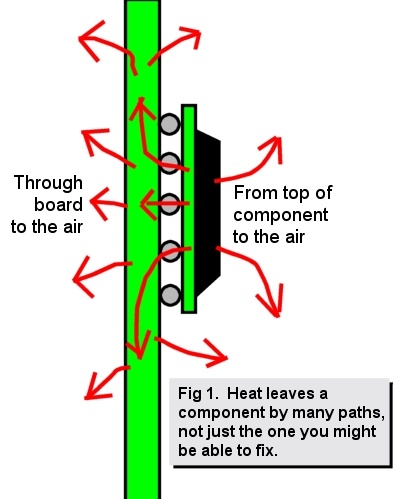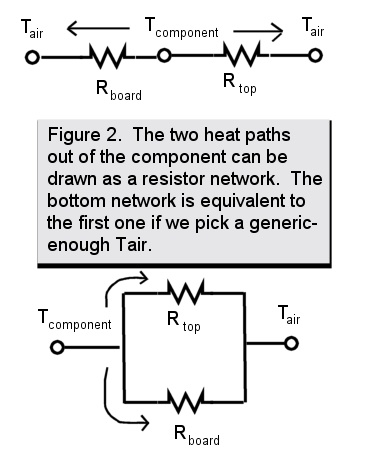|
answers to those doggone thermal design questions
by tony kordyban
dear everything-you-know guy,
what the heck is wrong with my heat sink? did i get a bad batch of aluminum or something? a microprocessor on my circuit board is running a little too hot, about 60 degrees c above the inlet air temperature to the box. so i added a heat sink that had about three times the surface area of the microprocessor package.
you're always harping on the idea that heat sinks work by increasing surface area. i expected the temperature rise to go down by 40 degrees, you know, in inverse proportion to the increase in surface area. that would give me a case temperature 20 degrees above the inlet air. ok, maybe not quite that low, being properly pessimistic. but the darn thing only went down 5 degrees!
what am i doing wrong? maybe i need a pin fin heat sink?
heatsunk in harrisburg
dear sunk,
keep working on that pessimism. only by imagining everything that could possibly go wrong will you ever achieve a true understanding of electronics cooling.
there are lots of reasons why a heat sink doesn't give you the temperature reduction you think you deserve. let's start with the reason that i call, with apologies to poet robert frost, "the road less traveled".
take a look at figure 1 for a reminder about something you probably already know. for your microprocessor, and for every other type of board-mounted component, there are two major paths for heat to get out to the air. heat passes directly from the "top" of the package directly into the nearby air. the other path is through the package leads, into the circuit board, where it spreads in all directions, and hen eventually into the air again.

there is resistance to heat flow from the top of the package, caused by the construction of the package itself, combined with the convective resistance between the surface of the package and the air. let's call that r(top). that is the resistance you are trying to reduce by adding a heat sink. increasing the amount of surface area in contact with the air passing by (i assume the air is actually moving, isn't it, sunk?) does directly reduce r(top).
then there is resistance to heat flow in the other direction. let's call that r(board). it depends on the resistance of the leads, the construction of the board (how much copper, how thick, how many vias, etc.), and the convective resistance between the surface of the board and the nearby air. it also depends on one other teensy, little factor: the location, power dissipation, and package resistance of all the other components on the board. this heat path is being shared by dozens of other heat sources, which makes it extremely difficult to quantify r(board).

at least in theory, though, and in figure 2, you know that these two paths exist. they both start at your component, and end with the surrounding air. the temperature of your part depends not on r(top) or on r(board), but on r(total), which is the combined resistance of both paths. even though i am a mere mechanical engineer, i remember how to add two resistors in parallel (or at least i know where the formula is written down).
r(total) = 1/[1/r(board) +1/r(top)]
this first equation gives can give you a sense of how r(total) changes with changes in r(top). this other form, algebraically the same, is simpler for plugging in numbers.
r(total) = [r(board) + r{top)]/[r(board) x r(top)]
keep reading, there are no integrals coming up. big deal, you say, what good does this little equation do me? i don't know what r(board) is! to find it i would have to do a detailed cfd (computational fluid dynamics) analysis of the whole board. if i bothered to do that, i could just figure out the heat sink performance directly. you are so right. r(board) is unknown and maybe unknowable. but we don't need to know it for this little equation to be useful. it can give us an idea of what is going on from just the relative values of the two resistances. for example, what if the board is made of solid copper? then r(top) could be much, much bigger than r(board). as r(top) gets larger and larger, then 1/r(top) gets smaller and smaller, approaching zero. when that happens, then r(total) gets closer and closer to equaling just r(board). in that case, practically all the heat is going into the board, and none into the air. if you add a heat sink to the component to reduce r(top), you are only taking some of the potholes out of a the road less traveled.
let's throw in some numbers to give you a more concrete feeling for this situation. say that r(top) is 100 times larger than r(board). r(total) ends up being 0.99 r(board). 99% of the heat flows through the board, and 1% from the top. that makes sense, since one path is 100 times the resistance of the other. now you add your heat sink and cut the resistance of r(top) to 1/3 of its original value, so now r(top) is only 33 times r(board). that should open up the floodgates from the top, eh?
r(total) is now 0.97 r(board). 97% of the heat still goes through the board. and because the component temperature rise depends r(total), it has gone down only about 2%.
remember, temperature rise = power x r(total)
so if r(total) goes down by 2%, then the temperature rise goes down by 2%.
try it yourself. what happens if r(top) starts out only 10 time larger than r(board)? r(total) is 0.91 r(top). if you add your heat sink and reduce r(top) to 3.3 times r(board), r(total) goes down to 0.77 r(board). temperature rise goes down by 14%. make a spreadsheet. plug in some relative values. you'll get the picture.
sunk, this sounds a lot like the problem you have described. but to illustrate my point about pessimism, i will give you a list of other possible reasons why your heat sink doesn't do what you expect.
high local air temperature - your expectation of how much the temperature should go down was based on the difference between the component temperature and the inlet air temperature. maybe the air approaching your heat sink has been heated by upstream components. what if the air rises 45 degrees before it ever gets to your part? that means there is only a 15 degree rise between your part and the "local ambient". if you add a heat sink and it goes down by 5 degrees, it is probably doing pretty well.
poor interface - is the top of your microprocessor bumpy and warped (or the bottom of your heat sink?) how did you stick them together? tiny air gaps conduct heat about as well as i can conduct the boston pops. you could be wasting 40 degrees of temperature rise through the interface resistance between the heat sink and the part. that is easy to check by measuring the heat sink temperature while measuring the component temperature. a big difference between case and sink means a lousy interface.
inept measurement method - don't discount this, because i have made this boo-boo myself occasionally. how are you measuring the component temperature? i usually glue a small thermocouple to the top of the package. but if you are going to measure the same way with a heat sink in place, how do you manage it? don't just dab some thermal paste right over the thermocouple and clamp down the heat sink! the thermocouple thickness will cause a gap that will screw up the interface. maybe the heat sink would work great if that sensor wire wasn't jammed in there. better to drill a tiny hole in the heat sink and attach the thermocouple to the case through it after the heat sink is properly mounted to the package.
really dumb stuff - are the heat sink fins lined up with the direction of air flow? are you sure you know which way the air is flowing across your component? it may not be as obvious as you think. is the heat sink really aluminum? they do make plastic heat sinks for some reason. don't take it personally, sunk. but in my job i've found it pays to check that the simplest, dumb things are being done right, before i start looking for more complex problems. here's the short advice to help you diagnose your problem. do your test again. measure your component case temperature, your heat sink temperature, and the approaching air temperature. that should give you a clue what to fix. unless it's hopeless. sorry, sometimes i get a little bit too pessimistic. and don't get me started on pin fin heat sinks. just forget about them. if you want more details on them, check out the chapter on them in my book.

about tony kordyban
tony kordyban has been an engineer in the field of electronics cooling for different telecom and power supply companies (who can keep track when they change names so frequently?) for the last 20 years. maybe that doesn't make him an expert in heat transfer theory, but it has certainly gained him a lot of experience in the ways not to cool electronics.
he does have some book-learnin', with a b.s. in mechanical engineering from the university of detroit and a master’s in mechanical engineering from stanford. in those 20 years tony has come to the conclusion that a lot of the common practices of electronics cooling are full of baloney. he has run into so much nonsense in the field that he has found it easier to just assume "everything you know is wrong" (from the comedy album by firesign theatre), and to question everything against the basic principles of heat transfer theory.
tony has been collecting case studies of the wrong way to cool electronics, using them to educate the cooling masses, applying humor as the sugar to help the medicine go down. these have been published recently by the asme press in a book called, "hot air rises and heat sinks: everything you know about cooling electronics is wrong." it is available at https://www.amazon.com/hot-air-rises-heat-sinks/dp/0791800741. this advice column is an extension of that educational effort.
|